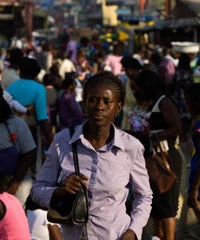The recent World Development Report on gender equality gives us some good reasons to be pessimistic about the state of gender relations in Africa. Over a million women in Africa die too early each year–many of them due to complications in child birth and HIV/AIDS. Women earn less than men, be it in agriculture, enterprises or the labor market. And tolerance for domestic violence is high–61 percent of women in Ethiopia think it is okay for their husband to beat them when they burn dinner.
But there are also reasons to be optimistic. The country with the highest percentage of female parliamentarians worldwide is Rwanda. Moreover, women are more engaged in economic activity in Africa than in most regions of the world–61 percent of African women participate in the labor force. And in some realms of the economy, the gender gap is smaller in Africa than in other parts of the world. A report [PDF] released this week on financial access shows that 22 percent of African women have an account at a formal financial institution compared to 27 percent of men (in South Asia, the numbers are 25 percent for women and 41 percent for men).
So the question then, is how do we make more of these bright spots? The answer: develop a comprehensive set of policies and interventions that tackle the underlying obstacles that constrain women’s equality. These include tackling the disproportionate amount of time that women have to devote to providing care to other members of the household , equalizing access to inputs they need to be economically productive, and addressing market and institutional failures that disproportionately affect women.
To make further progress–to get closer to equal–we also need policies and interventions that work. One of the best ways to determine what these are is rigorous impact evaluation. By rigorous impact evaluation, I mean where one group of individuals/households/communities is exposed to an intervention and an identical (or almost identical) group is not, and data is carefully collected to compare the two.
When we talk about policies for gender equality, this approach is particularly important. Why? First, many policy makers, particularly those that matter (think ministers of finance, ministers of agriculture) might believe in the principle of gender equality but are not convinced either that policies to ensure it work, and/or that there is a high return. Second, given that the domains of gender inequality (e.g. human capital, voice and agency, economic opportunities) are intertwined, policies are likely to have impacts in a number of these areas and establishing a clear causal link is key–not only for understanding impacts, but also adding up the payoffs. On the flip side, because of these complexities, impact evaluation, with its ability to test multiple interventions directly against each other, allows us to figure out which of the constraints that limit women need to be addressed first.
Evidence from these impact evaluations can be an important catalyst for change. Take a recent set of impact evaluations from India that look at the impacts of reserving local level government positions for women. They show that reserving seats for women results in a change in investment priorities [PDF] to be more in line with female preferences (infrastructure in particular), that the reporting of crimes [PDF] against women increased, that attitudes about the competence of female politicians [PDF] improved, and that women were more likely to be elected [PDF]. Finally, they show that having women in power changes the aspirations of parents [PDF] for their girls, and that those parents are then more likely to invest in their girls’ education.
To get progress towards gender equality in Africa, we need more of this kind of work – in the areas of women’s voice, adolescent empowerment, economic opportunities and health and education. When we know what works, we have a better shot at getting to equal.


Join the Conversation